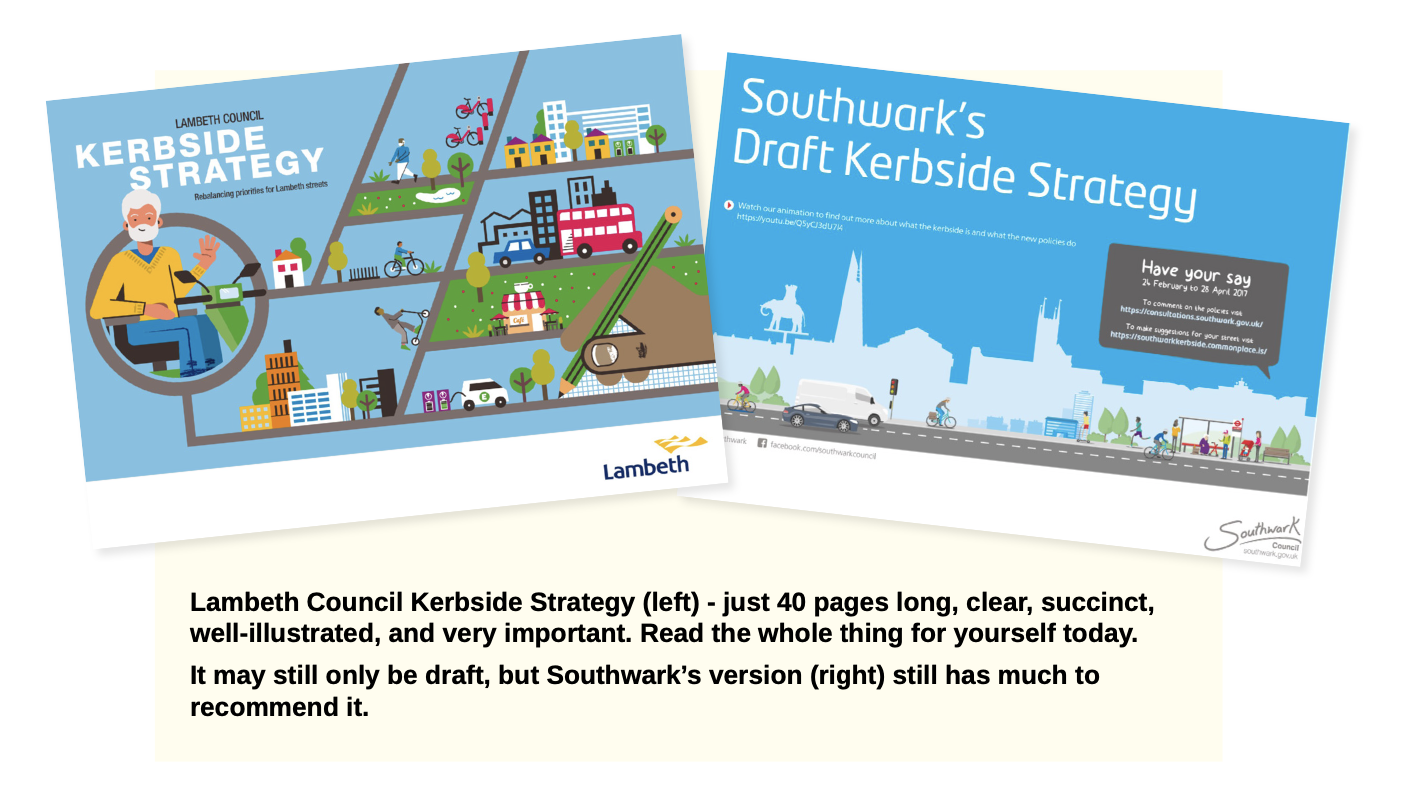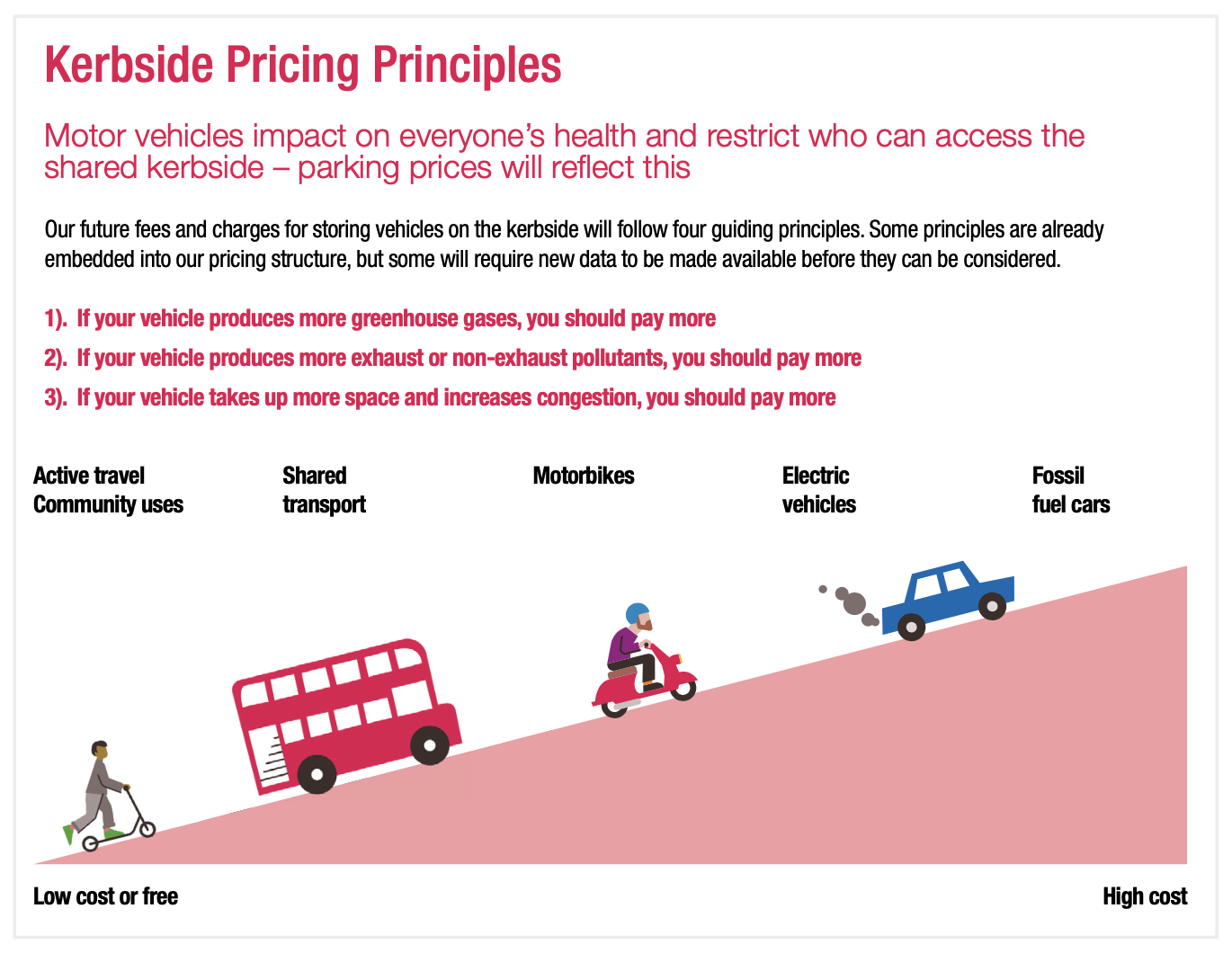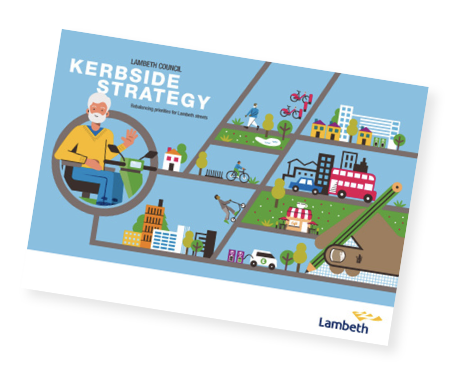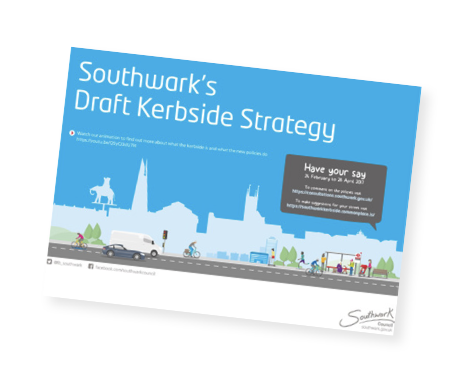TAPAS.network | 6 February 2023 | Commentary | John Dales
Hello kerbside - we have great plans for you at last!

Proper policies to assert the public interest in the valuable asset that is the kerbside have been absent for too long, has argued in these columns for some time. So he now warmly welcomes firm steps being made by local authorities to take active control of the kerbsides in their areas with well thought-through strategies and implementation plans that re-prioritise uses and achieve significant new benefits.
REGULAR FOLLOWERS of my columns will know that I have, in recent times, developed a keen interest in what does, doesn’t, should and shouldn’t take place at the kerbside, and especially in how we manage that precious resource. Accordingly, in a paper on Future Streets that I prepared for the Urban Transport Group last year, one of my eight recommendations concerned the need for local highway and strategic transport authorities to develop formal Kerbside Strategies to help ensure their better management.
At that time, I noted that there was only one such strategy in existence in the UK, and that even the one in question, the London Borough of Southwark’s, had not publicly progressed beyond its draft form published in February 2017. Just shy of six years later, there is at last a fully-fledged Kerbside Strategy in the public domain – and it isn’t Southwark’s. Rather, and as you may well have read in the last episode of LTT (issue 861), it’s that from one of Southwark’s next door neighbours – Lambeth.

The headline of that LTT news item proclaimed, “On-street parking to be slashed as Lambeth sets out kerbside strategy”, understandably going for the most eye-catching takeaway. This might be considered sensationalism but, in highlighting the parking issue, the item was simply taking a lead from the strategy itself. The Executive Summary begins with the words, “The kerbside – most easily recognised today as the space where cars park – is one of the largest public assets we have control over… Today, 94% of the kerbside is used to provide and manage car parking”.
Treat that last statement with caution, however, because that 94% figure – though I don’t question its technical accuracy in the Lambeth context – may be misleading. It bears an interesting, but accidental, similarity with the figure that RAC Foundation research has revealed to be the proportion of its life that the average car is parked: 96%. But none of us makes the mistake of thinking the remaining 4% of a car’s life is at all marginal or trivial, not least because of the many negative outcomes associated with moving cars: death, injury, air and noise pollution, carbon emissions, community severance and economic inefficiency.
So with ‘The Lambeth 6%’. This is by no means of little import, in comparative or absolute terms, for the amount and variety of vehicular activity clamouring for access to the kerbside is huge – and growing almost daily. The size of the car parking kerbside time share is, in itself, almost an abstract issue. It’s the fact that car parking places unacceptable limitations on all these other activities that is of critical importance. And that, of course, is why Lambeth has produced its strategy. Put simply, the strategy is the physical manifestation of the statement “We want to use our kerbside for more productive uses, and this is how we propose to go about it”.
I’ll come onto the Lambeth document itself in more detail, and indeed the Southwark draft, in a moment. But, first, a brief reflection on another of the recommendations in my paper for the Urban Transport Group: that we’re in urgent need of a shared practical definition of what the kerbside actually is.

They don’t call it a modal parking charges hierarchy, but that’s what it is. Diagram from Lambeth’s Kerbside Strategy
The original Department for Transport Manual for Streets (MfS, 2007) provided such a definition for ‘a street’, as distinct from a road, in the following form: “A highway that has important public realm functions beyond the movement of traffic...” This appropriately recognised the inherent complexity of street use, and helped streets be better understood and designed. It barely mentioned the kerbside, however, and when the word ‘kerb’ was used it was almost always in relation to the physical object forming the kerb, or to its role as a simple boundary line (as in kerb-to-kerb distance).
I was therefore unsurprised, but glad, that recent user research by Deloitte for the DfT found that “a shared, formal definition for managing access to the kerbside does not exist, and is required”. I could hardly agree more. Defining ‘the kerbside’ as a physical environment, a valuable asset, and an integral part of the places we call streets would mean, in the first place, that we’d hopefully pay it the attention it deserves. A definition would necessarily embrace the operational (dynamic) aspects of streets, not just the physical (design) aspects that MfS understandably focused on. And it would make obvious the need for a joined-up approach to kerbside allocation and management.
In many ways, the kerbside today is a textbook example of ‘the tragedy of the commons’: a situation in which individuals act in their own interest when using a public resource and, in doing so, ultimately deplete it. Defining the kerbside as a place of shared endeavour and of potential mutual benefit – not just a line between footway and carriageway – would give direction to the work of many actors in the urban, transport, community and commercial worlds, and enable the whole to be much more than the sum of the parts.
The kerbside needs to be actually understood as a ‘place within a place’; an area of exchange where footway and carriageway meet, and one that people approach and use from both sides. With that very much in mind, let’s go back to Lambeth and its new Strategy.
“This is about fundamental change in response to the climate emergency”, is a phrase not many of us would have expected to see upfront in a document entitled a Kerbside Strategy. But it’s both heartening and, if I may say so, a validation of my take on the importance of understanding and managing the kerbside better. It would have been rather marvellous if the headline in the LTT861 news item had been “The kerbside can save the planet”, though I appreciate why it was not.
But Lambeth and I don’t just see eye to eye in respect of the importance of the kerbside – we are seemingly at one when it comes to the need for a definition. Under the heading ‘What is the kerbside?’, the strategy says: “The kerbside is a public space – it belongs to all of us. It’s the single largest public space we have, and a place that everyone should have access to”. I love that, and I also love how the kerbside is described as Lambeth’s ‘doorstep’, though I take issue a little with it being given that description only on the basis that it is “the start and end of our journeys”. The kerbside is a place in its own right, as are most doorsteps.
The draft Southwark strategy, from way back in 2017, (its status is now rather unclear) also had/has a heading ‘What is the kerbside?’, perhaps proving that imitation is indeed the sincerest form of flattery. Under it, Southwark write that, “The kerbside is the space which people often think is just for car parking. It is the space on the public highway that is next the footpath (i.e. at the kerb). For the purposes of this document, this includes both the carriageway and nearside footpath space”. Excellent stuff. The definition then goes on to list a range of kerbside uses, including street seating, bus stops, cycle and car parking, waste collection, servicing and deliveries, tree planting, market stalls, historic white posts and grass verges. Better and better.
Lambeth’s strategy focuses on four key priorities. The text about them below each heading on the next page is copied directly from the strategy, because it doesn’t need editing or improving.
Lambeth’s Four Kerbside Strategy Priorities (2023)

-
Enable accessible and active travel
This means using the kerbside to ensure that our pavements are clear and accessible, particularly for people with mobility impairments. This also includes minimum commitments for cycle parking and shared bikes, and high-quality walking networks. A kerbside basic example is committing to all households being within 50m of free cycle parking.
-
Create Places for People
Kerbside uses that create social spaces on our streets. Many households don’t have outdoor space or a car and can’t make use of the kerbside either. That will change with this strategy. Local people will be able to apply to use the kerbside for small community gardens. Businesses will be able to apply to use the kerbside for outdoor seating. We will build on the successes of pilot schemes over the last few years.
-
Increase climate resilience
Our summers are already getting hotter, and flooding is a growing risk. The impacts of climate change will not be felt equally and people on lower incomes, who are sick, or the elderly are all at greater risk. This strategy pledges that all streets will have shade from trees and green spaces and biodiversity that together help protect us from these risks. A kerbside basic example is street trees every 25m on every street in Lambeth.
-
Reduce emissions and traffic
Once we reach our ambitious targets for sustainable transport and traffic reduction, there will be far fewer motor vehicles on our streets. But for those that remain we need to support the shift towards electric vehicles and shared cars as much as possible. We must provide the infrastructure and incentives to support this shift quickly, and at scale.
You might have noticed the use of the phrase ‘kerbside basic’ in that text above. These are a series of minimum expectations for every street in the borough, there being ten such items under the first priority, four each under the second and third priorities, and six under the fourth priority. I very much enjoyed how the strategy introduces these by saying, “We used to insist on minimum requirements for car parking, we are now insisting on minimum requirements for sustainable uses of the kerbside”. Top marks Lambeth.
Lambeth’s new parking strategy is cheekily bundled as a bonus under the fourth priority, and comes with five additional kerbside basics of its own (the numbering actually goes up to six, but there isn’t a no.2). Once more I derived joy from this, and not simply because of the fact that Lambeth – rightly, in my view – consider the parking strategy to be subordinate to the kerbside strategy. What really got me smiling was the rather excellent graphic that illustrates what is, in effect, a modal parking charges hierarchy. A great idea and very clearly articulated. I also noticed that the strategy says the parking charges will follow four guiding principles, but only three are listed. Maybe I missed my true calling as a proof-reader!
I really need to curb my enthusiasm for this topic now, and bring things to a conclusion, but let me just quickly note that, whilst Lambeth has four priorities, Southwark went for twice that many equivalent policies in their draft strategy:
Southwark’s Proposed Kerbside Priorities (from 2017 draft)

-
Policy 1
Allocate kerbside space in accordance with Southwark’s Street Wise approach
-
Policy 2
Prioritise kerbside space for walking and cycling
-
Policy 3
Implement parking controls based on an evidence-led approach
-
Policy 4
Review parking in town centres
-
Policy 5
Require safer, robust delivery, servicing and waste management
-
Policy 6
Implement more green infrastructure
-
Policy 7
Expand the shared mobility network
-
Policy 8
Adapt our kerbside to meet future needs
As so often when I write about what others have written, the main thing I’m really trying to do is to get you to read the original material yourself. Both the Lambeth and draft Southwark strategies are readily available to download, and they’re just 40 and 43 pages long respectively. The relevant links are at the end of this piece. That Lambeth may possibly have picked up tips from their neighbour in another way is suggested in that both documents are not just admirably brief, but that they’re also attractively presented, with large text, plenty of pithy phrases and bullet points, and loads of graphics.
Writing a document is one thing, and effecting real change at the kerbside is another of course. It won’t be easy, but it’s very important. As the Lambeth strategy notes, “On most streets, the kerbside is where you will find cars parked and all too often, not much else. This is not a fair or efficient use of space, especially when most people don’t own a car. We’re so used to the kerbside being like this that it can be hard to imagine anything different, but change is necessary and possible.”
Just having a strategy doesn’t get the job done; but, without one, better use of the kerbside definitely won’t get done. If you work for, with, or on behalf of a local highway authority, why not start a conversation about creating one of your own?
You’ve got one official, and one unofficial, excellent examples to show you the way.
References and Links
-
Lambeth Council Kerbside Strategy
-
Manual for Streets, 2007 : DfT NB revised version in preparation
John Dales is a streets design adviser to local authorities around the UK, a member of several design review panels, and one of the London Mayor’s Design Advocates. He’s a past chair of the Transport Planning Society, a former trustee of Living Streets, and a committee member of the Parliamentary Advisory Council for Transport Safety. He is director of transport planning and street design consultancy Urban Movement.
This article was first published in LTT magazine, LTT862, 6 February 2023.
You are currently viewing this page as TAPAS Taster user.
To read and make comments on this article you need to register for free as TAPAS Select user and log in.

Log in